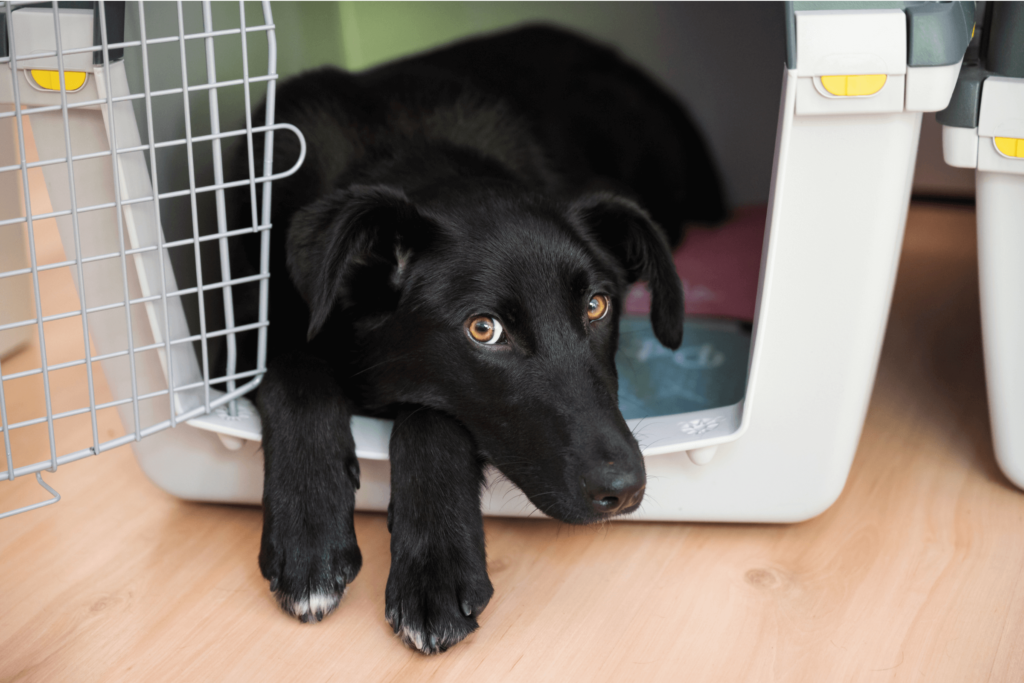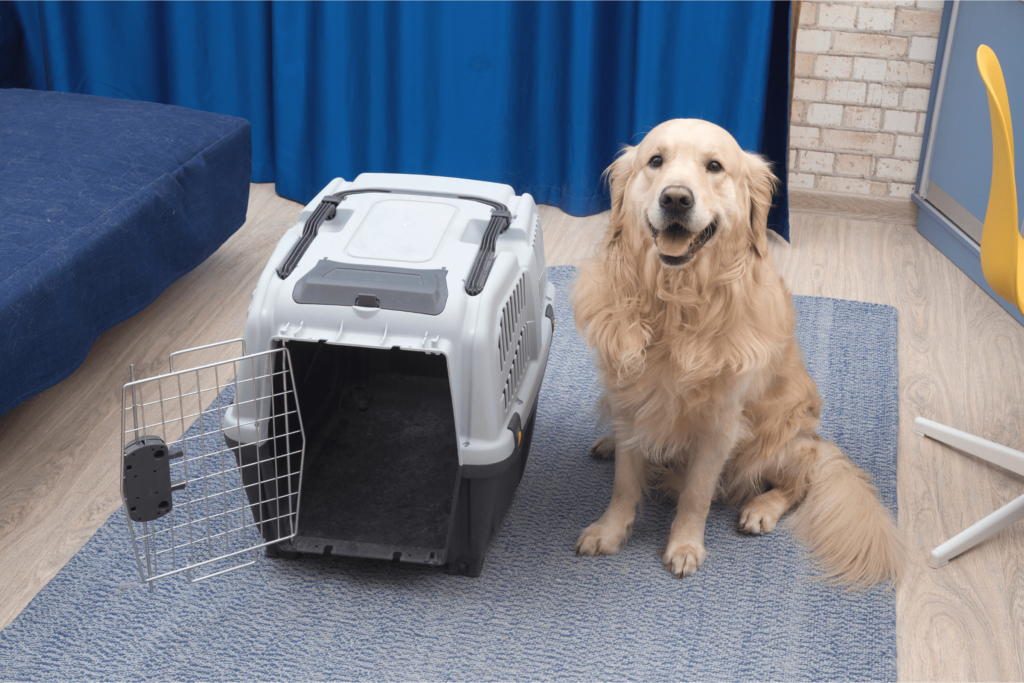Most pet parents would love to take their dogs on trips with them via plane, but many people do not fully understand the implications of bringing a dog on a plane. Air travel can have serious negative effects on dogs.

Flying with a dog can be stressful for your pet (and on you!). From the security line, to new sights, sounds, and airplane pressure, your pup won’t understand what’s going on.
Read on to understand the effects flying has on dogs, plus 5 things to consider before booking your canine companion a flight.
How Does Flying Affect Dogs?
In addition to emotional effects of flying like stress and anxiety, there are physical effects a dog can experience from air travel. Here, I break down both categories of how a dog can be affected emotionally and physically from flying.
Emotional Effects
Stress – When traveling by air, your dog’s crate or carrier may be handled by people they do not know, which can be very stressful to some dogs. If a dog is separated from their pet parent on a flight, being placed in the cargo hold, that could elevate their stress level even further.
Fear of the unknown – Most people are afraid of the unknown, but imagine how dogs feel!
We don’t speak their language to be able to tell them what’s going on and that everything will be alright. They just know they have been thrust into a new environment with sounds, sights, and people they’ve never experienced.
Try to think about the situation from your dog’s perspective before booking them a flight – especially in the cargo area.

Separation anxiety – Dogs that experience separation anxiety when their parents leave the room or the house, very well may experience a heightened sense of that same anxiety when flying.
Even if your dog is flying in the cabin with you, he or she is still contained to a carrier under the seat in front of you. And in if they are flying in the plane’s cargo hold, the feeling of being separated from their human while experiencing the unknown may just be unbearable.
Physical Effects
Ear pain – Similarly to humans, your dog’s ears are vulnerable to pressure changes due to high altitudes. Therefore, flying can cause pain to your dog if it can’t correctly equalize its ears to the changing air pressure.
The good news is that a dog’s outer ear canal naturally equalizes pressure in the ear, so if your dog does experience pain or discomfort throughout the flight, it should go away in a couple of minutes.
Breathing issues – Brachycephalic dogs (also known as short- or snub-nose dogs), like Pugs, American Pitbulls, Boxers, and French Bulldogs, have physiology that impairs their breathing when flying due to changing pressures in altitude.
Many airlines do not allow these breeds in airplane cargo holds.

Body temp regulation – Dogs that have been given a sedative or tranquilizer for their flight have trouble regulating their body temperature at high altitudes. Look into calming drops or CBD treats instead.
Dry skin – Like humans, a dog’s skin dries out on a plane because of very low humidity, which causes their body to expel moisture, eventually causing dry skin. This can be quite itchy for a dog!
Self-harm – Some dogs who are stressed may display nervous habits like incessant licking or chewing of their skin or paws or their crate. This can result in serious injury of the dog!

One of our dogs, when boarded, gets extremely stressed and has actually ended up with raw patches on his paws and legs from the constant licking and biting. He’s also lost teeth from biting at the kennel! It’s heartbreaking.
Death – One relieving note is that Veterinarians.org created a report which organized all the data recorded by the U.S. Department of Transportation, titled Pet Friendly Airlines: The Best and Worst Airlines for Pets in 2021. This report named Alaska Airlines the best airline for pets, thanks to their fewest reported incidents.
To be clear, an “incident,” according to the DoT, includes death, injury, and loss of pets. Veterinarians.org states that Alaska Airlines transported over 730,000 from January 2015 to December 2020 while maintaining an incident rate of 0.26%.
5 Things to Consider Before Flying With Dogs
Before booking your pup a plane ticket, there are 5 things you should consider about how flying affects dogs. Read on for more and comment below with any questions you may have!
1) Is Taking Your Dog on a Flight Essential?
Before taking your dog on a plane with you, consider whether it’s necessary. Flying your dog should be your last resort, so explore your options first. If transporting your dog by car isn’t possible, see if a friend or family member is willing to dog-sit for a few days.
Flying is a dangerous ordeal for your dog since there are a lot of uncontrolled variables at play (especially if flying your dog in the cargo hold of a plane).
If you don’t need your dog accompanying you on your trip, consider leaving them at home. You may miss each other, but it keeps your dog in a safer, and calmer environment.
2) How Stress-Prone is Your Dog?
Your success with flying may not be a result of the airline and the moving cargo but how well your pet handles stress. Of course, flying can be stressful for many dogs, but not necessarily overwhelmingly stressful for all dogs.
Before taking your dog on a flight with you, ask yourself the following questions about your dog:
- How does your dog interact with other people and animals?
- Is your dog highly sensitive to loud noises or sudden movements?
- Will your dog panic if they’re away from you for long periods?
- Is your dog a rescue dog? Or a dog that has a traumatizing past?

Ask yourself these questions before flying with your dog. It’s always best to honestly evaluate their temperament and triggers before putting them in a situation that can be dangerous for them.
3) Where Will Your Dog Fly, in the Cabin or Cargo Hold?
Another important deciding factor you’ll have to establish before booking your dog’s trip is where they will travel during the flight. You have two options: flying in the cabin with you or sending them to fly in the cargo hold with luggage and (potentially) other animals.
Flying in the cabin with you:
If your dog is small enough (and meets the specific airline requirements), he or she may be able to fly in the cabin with you! Cabin flying (a.k.a. flying as a carry-on) means that your dog must be able to fit comfortably in a carrier that can stow under the seat in front of you.

The upside to having your dog fly in the cabin is that they’re with you during the flight, you can check on them, and they’re less likely to experience as much separation anxiety.
However, cabin flying can sometimes be expensive, and most airlines limit you to bringing only one dog in the cabin per flight. Luckily, if you fly with Alaska Airlines you’re allowed to board with two dogs in the cabin so long as you purchase the seat adjacent to yours.
Flying in the cargo hold:
The cargo hold is an area of planes that may be temperature regulated depending on which airline you travel with.

As a rule of thumb, most flights that accept pets have a climate-controlled cargo hold, similar to the passenger cabin above. However, not all airlines offer this, so the cargo hold can get very cold or hot, depending on the time of year.
In general, I only recommend having your dog fly in the cargo hold if it is absolutely necessary (i.e. an international move or long-term vacation). Although airlines try to keep all animals comfortable while in the cargo hold, uncontrollable variables can make a stressful flying experience for your dog.
For example, not only is your dog separated from you, but luggage can tumble while in the cargo hold during the flight. Overall, noises are louder in the cargo hold that would be in the cabin, and any turbulence can increase their anxiety.
Although you can argue that tons of animals (not just dogs) fly in the cargo hold each year without issue, there are many things you have no control over when handing your dog over to airline personnel.
One way to think of it is: Baggage handlers are there to do their job, load the plane. There is no guarantee they’ll be extra cautious when handling your pet. And again, while many travelers go without issue when flying their furry companion, many others have traumatizing experiences with their pet getting injured, ill, or dying during or after flying in the cargo hold.
Before taking your pet with you on a plane, I always urge pet owners to really consider whether the risk is worth taking.
If you must send your dog to fly in the cargo hold, you can do a few things to make the experience as smooth as possible.
First, book a direct flight during cooler months to avoid extreme temperature changes, and put a “Live Animal” sticker on your dog’s carrier. This will let the airline staff know to handle your pet with care.
You should also avoid tranquilizing your dog before the flight, as this can be extremely dangerous at high altitudes. If your dog experiences motion sickness, there are products available that can help with mild cases, like the Thunder Shirt.

4) What is the Age of Your Pet?
The minimum age requirement for dogs to fly is 8 weeks old (and they mush be fully weaned).
Also, older dogs are oftentimes more anxious than younger pups, and the stress of flying can have a greater impact on them, especially if they have pre-existing health conditions.

5) What Breed is Your Pet?
Most airlines will not permit short-nosed (or or brachycephalic) dogs on planes – specifically in cargo hold areas. Since their breathing is already labored on a normal, day-to-day basis, airplane pressure experienced at flying elevations can send them into respiratory distress.
Some of the breeds that are prohibited on many airlines include Mastiffs, Pugs, Shih Tzus, Staffordshire Bull Terriers, Brussels Griffon, Bull Terriers, and Boxers.

Things You Can Do to Make Your Dog Comfortable on a Plane
Ensure your crate meets plane requirements and is the right size for your dog. Most airlines have specific requirements for what type of crate you can use, so check with your airline ahead of time.
Note: Your dog’s crate is too small if it can’t properly stand and turn around while in it.
Train your dog to be crate-comfortable. At least a month before your flight, begin laying the groundwork for having your dog feel comfortable in a crate. As you progress, try extending the amount of time your dog spends in the crate. Once your dog is comfortable staying in the carrier for long periods, you can begin to work on getting them used to the sensation of flying.

To do this, put your dog in its crate and take them for short car rides around the block. If your dog starts getting anxious or seems uncomfortable, take breaks, and give them plenty of positive reinforcement. The goal is to get your furry companion to the point where they associate the crate with positive experiences.
Desensitize your dog to triggers. Many things can trigger anxiety in dogs, from the sound of an engine to the movement of a plane. If your pup is particularly anxious, it may be helpful to desensitize them to these triggers ahead of time.
To do this, start by exposing your dog to short videos or recordings of the triggers. If your dog remains calm, gradually increase the volume or length of the exposure. Once your dog is comfortable with these recordings, you can begin to expose them to the actual triggers.
If your dog becomes anxious or uncomfortable at any point, make sure to back up and give them plenty of time to adjust. You want to get your dog to a point where they no longer react to the triggers.
Give your pup a blanket or shirt with your scent. For your dog, being separated from their human in an unfamiliar environment (even if you’re seated close together) can be scary.
Airlines allow you to place one of your shirts or a small blanket with your scent in the crate to help relax your dog. Having a familiar scent with them throughout the trip may be quite the comfort!
Give your dog plenty of exercise. A tired dog is a calm(er) dog, so it’s essential to ensure your dog is getting enough exercise before the flight. A long run or walk will help to exhaust them and relieve some pent-up energy.
In the days before your flight, ensure to increase the exercise your dog is getting. This will help to ensure they’re as calm and relaxed as possible when it’s time to fly.
Conclusion
Flying with a dog can be stressful for the pet and owner. And while no plane ride will be entirely stress-free, there are things you can do for both you and your dog to help relax. Following these tips can help make the experience as smooth as possible for everyone involved.
Check with your airline about specific requirements, get your dog comfortable in a crate, and desensitize them to any potential triggers. Finally, give your furry friend plenty of exercise before the flight. You and your pup can enjoy your travels with some preparation.
Do you have any additional tips that have calmed your dog while flying? Let me know in the comments below!
Related Posts
- A Comprehensive Guide to Flying with Dogs: Tips, Rules, and Resources
- Flying With Dogs on Alaska Airlines (Pet Travel FAQs)
- Where Do Dogs Fly on Planes (Cargo vs. Cabin vs. Baggage)?
- What is the Cost of Flying with Dogs (Fees and Considerations)
- What is the Cost to Fly a Dog Internationally?
- Everything to Know Before Flying With Big Dogs

2 Comments on How Does Flying Affect Dogs (5 Things to Consider)
Comments are closed.